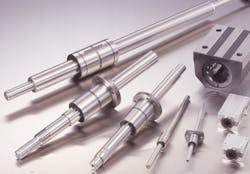5 Essential Facts About Ball Splines for Engineers
Ball splines are sometimes misunderstood in the intricate landscape of high-precision engineering. For one, they can be mischaracterized as fragile, or ill-suited for heavy loads.
But these innovative multiaxis components are designed to be robust and, contrary to misconceptions, technical literature highlights that rolling ball elements enable low friction even under heavy loads.
The first ball spline, developed in 1971 by THK, was a precursor to linear motion guides, which were introduced a year later. Ball splines were designed from the get-go to achieve smooth motion by combining low-friction torque transmission with smooth linear motion in a single mechanism. They consist of an outer cylinder, retainer, side rings and ball elements.
Ball splines achieve distinctive performance by using the rolling motion of ball elements. Contained in a retainer, the balls circulate along one or more machined splines (axial grooves) on the shaft. This design creates a low-resistance pathway for the balls to travel smoothly and efficiently along the length of the shaft.
A properly engineered ball spline enables effective torque transfer and allows smooth linear motion along its axis. This makes it especially suitable for applications that require both rotational and sliding movements under load. Leading manufacturers use high-strength alloy or hardened steel materials that undergo surface treatments to enhance wear resistance and ensure durability throughout the component’s operational life.
Ball splines are well-suited for applications that require both precise linear motion and the ability to simultaneously transmit torque. This makes them ideal in systems where components must slide smoothly along a path while maintaining controlled rotational force, such as in robotics, automation equipment and CNC machinery.
The ball spline’s design ensures accurate positioning and reliable torque transfer under load. Therefore, it serves simultaneously as a linear guide and a shaft that carries torque, all in one design.
Following are five key points about optimal ball spline design and function.
1. Ball splines are not to be confused with linear bearings.
Both ball splines and linear bearings use recirculating balls. However, the principal difference is that ball splines benefit from unique architecture that integrates rotary and linear motion on a single shaft. This feature provides flexibility in complex motion schemes. Linear bearings primarily facilitate smooth, low-friction linear movement and provide smooth linear motion—but they do not transmit torque.
2. Groove geometry influences performance and lifespan.
Designers commonly assume all ball spline profiles behave similarly. However, the groove shape (gothic-arch vs. circular) has a direct effect on load capacity, precision, speed, smoothness and ball contact angles. Gothic-arch grooves offer four-point contact between the balls and the raceways, which results in higher rigidity and increases load-bearing capacity. These ball splines are suitable for robotics and CNC applications, where stiffness and accuracy under heavy loads need to be factored in.
By comparison, the two-point contact circular-arc grooves provide two-point contact, which results in smoother motion and less resistance under the load. This option also means lower friction and quieter operation. Applications can be found in high-speed lab automation and instrument rails, where minimizing noise is crucial.
Design engineers routinely consider these differences for overall mechanical efficiency, precision tolerance and durability.
3. Sizing a ball spline should be left to technical experts.
Selecting and sizing a ball spline properly requires a technical evaluation of the ball spline parameters. A comprehensive approach to specifying ball splines involves multiple considerations, including shaft strength and deflection; service life calculations, dimensional and load limits and conditions; as well as preload and rigidity requirements for the application. Familiarity with design guides, manufacturer catalogs and even software tools can be helpful, too.
4. Lubrication is a standalone consideration.
Lubrication is generally necessary. Some ball spline designs feature built-in lubrication channels that extend maintenance intervals or provide near maintenance-free operation in some conditions. Lubrication channels are integral to the design and function and are placed in a manner that effectively delivers lubricant while maintaining mechanical integrity. The lubrication method (grease or oil) and frequency depend on key factors, such as speed, load, contaminants and environment. Regular maintenance is important to avoid premature wear and failure.
5. Stay informed by consulting up-to-date literature on ball spline fundamentals.
Advances in technology, including groove profiles, built-in sensor integration and predictive maintenance techniques, are continuously evolving best practices for selecting and designing ball spline systems. Keeping current with these developments ensures regulatory compliance and prevents costly redesigns. Moreover, it guards against the risk of using outdated and inaccurate assumptions in engineering decisions.
Start by browsing the resources below for more useful guidance on ball spline and other associated linear motion technologies:
- What’s the Difference Between a Ball Spline and a Bearing?
- The Power of a Ball Spline: Design, Function, Applications
- Bearing the Load in Rotary Ball Spline Design
- Top Tips: Select the Right Ball Splines for Rotation or Linear Motion
More interesting reads on the evolution of mechanical components
- Linear Bearings and Actuators for Applications
- Linear Bearing Design Considerations
- How “Smart” Components are Getting Smarter: Valves, Bearings, Gearboxes and Brakes
- Eight Red Flags to Avoid for Longer Ball Screw Life
About the Author

Rehana Begg
Editor-in-Chief, Machine Design
As Machine Design’s content lead, Rehana Begg is tasked with elevating the voice of the design and multi-disciplinary engineer in the face of digital transformation and engineering innovation. Begg has more than 24 years of editorial experience and has spent the past decade in the trenches of industrial manufacturing, focusing on new technologies, manufacturing innovation and business. Her B2B career has taken her from corporate boardrooms to plant floors and underground mining stopes, covering everything from automation & IIoT, robotics, mechanical design and additive manufacturing to plant operations, maintenance, reliability and continuous improvement. Begg holds an MBA, a Master of Journalism degree, and a BA (Hons.) in Political Science. She is committed to lifelong learning and feeds her passion for innovation in publishing, transparent science and clear communication by attending relevant conferences and seminars/workshops.
Follow Rehana Begg via the following social media handles:
X: @rehanabegg
LinkedIn: @rehanabegg and @MachineDesign
